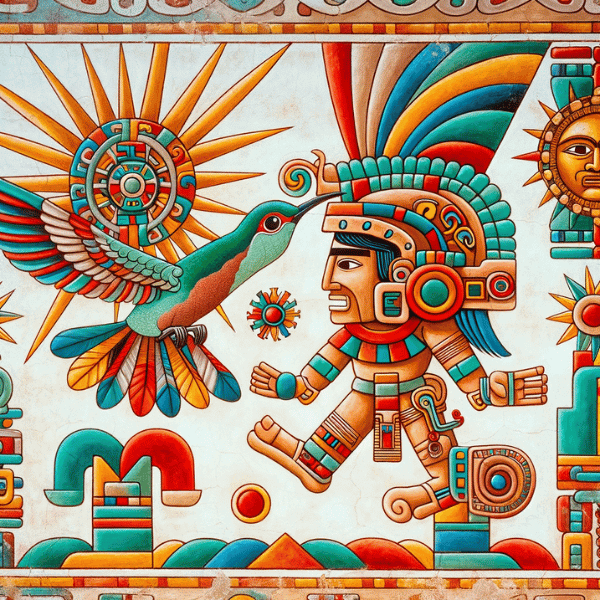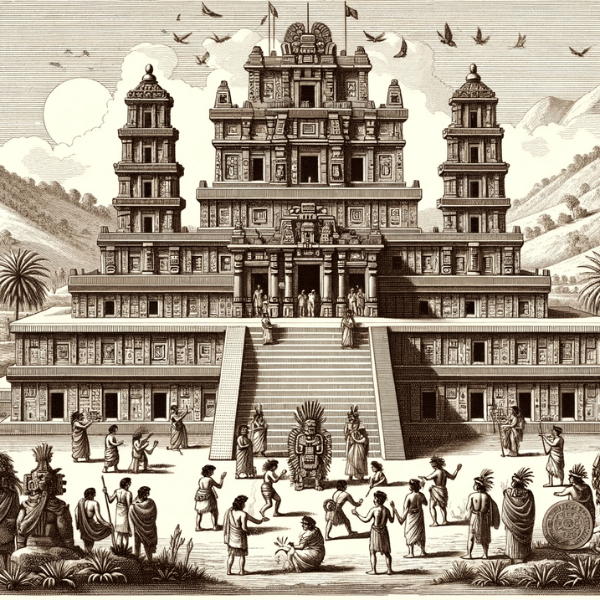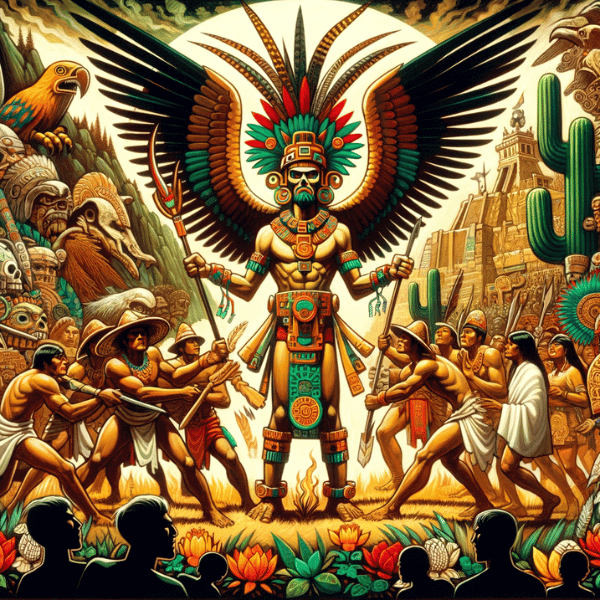Huitzilopochtli, a central figure in Aztec mythology, stands as a symbol of might and divine guidance. Revered as the god of the sun and war, he was pivotal to the Aztecs, profoundly influencing their societal structure, religious practices, and military conquests. His narrative, rich with symbolic elements, intertwines with the Aztecs’ understanding of the cosmos and their place within it. Huitzilopochtli, the patron deity of Tenochtitlan, the heart of the Aztec empire, deeply embedded his presence in the daily lives and spiritual consciousness of the Aztec people. His story, transcending mere mythological lore, encapsulates the essence of Aztec culture and religious philosophy, offering a window into the soul of an ancient civilization.
| Attribute | Huitzilopochtli Information |
|---|---|
| Origin | Aztec Mythology |
| Deity Type | God of War, Sun, and Patron of Tenochtitlan |
| Appearance | Often depicted as a warrior god with a hummingbird headdress and a serpent weapon |
| Role | God of war, the sun, and the patron deity of Tenochtitlan, the Aztec capital |
| Hummingbird | Associated with the hummingbird, which represented his spirit and was a symbol of warriors |
| Human Sacrifice | Required human sacrifices to sustain the sun and ensure victory in battle |
| Cultural Impact | Central figure in Aztec religion and society, symbolizing power and protection |
| Depictions | Featured in Aztec art, rituals, and mythology, especially those related to warfare and the sun |
1. Historical and Cultural Context
Origin in Aztec Mythology
Huitzilopochtli’s story begins with his dramatic birth, a tale steeped in power and prophecy. According to Aztec creation myths, he was born fully armed from his mother Coatlicue, the earth goddess, ready to defend her from the wrath of his siblings, the moon and stars. This myth not only symbolizes the daily triumph of the sun over night but also represents the struggle for balance and order in the universe. Huitzilopochtli’s birth, as recounted in the ‘Florentine Codex’, a primary source by the Franciscan friar Bernardino de Sahagún, is a testament to his perceived power and sovereignty, embodying the Aztec ideals of bravery and resilience.

Role in Aztec Society
Huitzilopochtli’s influence profoundly permeated Aztec politics, warfare, and societal norms. As the patron deity of the Mexica tribe, he guided them to the site where Tenochtitlan, their great city, was founded. This narrative, central to Aztec identity, legitimized their rule and conquests. In warfare, he was invoked for strength and victory, often depicted in art and inscriptions as a fierce warrior. Archaeological evidence, such as the Templo Mayor in Tenochtitlan, serves as a testament to his importance, revealing insights into the rituals and ceremonies performed in his honor. Experts in Mesoamerican history, like Dr. Eduardo Matos Moctezuma, highlight how Huitzilopochtli’s cult shaped the Aztec’s militaristic and expansionist policies, cementing his role as not just a religious figure, but a driving force in the Aztec way of life.
2. Symbolism and Representation
Iconography and Attributes
Aztec art and architecture portray Huitzilopochtli with distinctive iconography that reveals much about his perceived attributes and powers. Typically depicted with a hummingbird helmet and adorned with blue and green feathers, he resonates with the symbolism of the sun and war. The hummingbird, a creature known for its agility and combative nature, symbolizes the god’s association with war and the sun’s daily journey across the sky. This imagery is prominently featured in murals, sculptures, and temple decorations, such as those found in the Templo Mayor. Additionally, his representation often includes a shield adorned with five feathers and a spear-thrower, signifying his role as a divine warrior and protector of the Aztec people.

Interpretations and Modern Perspectives
Over time, interpretations of Huitzilopochtli have evolved, providing a deeper understanding of his significance in Aztec culture. Modern scholars, like Dr. Michael E. Smith, offer perspectives that contextualize his role beyond the realm of mythology. They propose that Huitzilopochtli’s worship reflected the Aztecs’ values and socio-political ambitions, underpinning their imperialistic endeavors and societal structures. His symbolism in rituals and ceremonies, as understood today, sheds light on the Aztecs’ perception of the cosmos and their place within it. This contemporary analysis enables a reevaluation of Huitzilopochtli, not only as a mythological figure but as a cornerstone of Aztec cultural identity and cosmological understanding.
3. Rituals and Worship
Ceremonies and Sacrifices
Rituals and sacrifices dedicated to Huitzilopochtli were fundamental aspects of Aztec religious life, epitomizing their devotion and spiritual beliefs. The most significant of these was the Panquetzaliztli festival, a winter solstice celebration marked by elaborate ceremonies and human sacrifices. In these practices, the Aztecs believed that they were nourishing and empowering Huitzilopochtli, often using prisoners of war, to ensure the sun’s return and the continuation of life. From a historical and ethical standpoint, modern analysis of these practices uncovers a complex interplay between religion, politics, and societal norms. Scholars like Dr. Elizabeth M. Brumfiel offer nuanced insights, suggesting that while contemporary standards may perceive these rituals as brutal, they were deeply ingrained in Aztec cosmology and played an essential role in maintaining cosmic order and societal cohesion.

Temples and Sacred Sites
The Templo Mayor in Tenochtitlan stands as the most prominent temple dedicated to Huitzilopochtli. This massive structure, a symbol of Aztec architectural ingenuity, was the center of religious life in the Aztec capital. Its dual shrines, one for Huitzilopochtli and the other for the rain god Tlaloc, illustrate the god’s paramount importance. Archaeological excavations at the site have unearthed a wealth of artifacts and relics, offering invaluable insights into the Aztecs’ worship practices. Experts like Dr. Leonardo López Luján have analyzed these findings, demonstrating the intricate linkage between the physical spaces of worship and the Aztecs’ spiritual and daily lives. They showcase Huitzilopochtli’s enduring presence in their cultural and religious landscape.
4. Huitzilopochtli in Epics and Narratives
Presence in Aztec Literature
Huitzilopochtli’s presence in Aztec literature and oral traditions is profound, illustrating his significance in the cultural narrative. Epic tales, such as the legend of the Mexica’s pilgrimage and founding of Tenochtitlan, centralize him as a guide and protector. These narratives, passed down through generations, depict him as a decisive and commanding figure, steering the fate of the Aztec people. An analysis of these stories, including their themes and motifs, reveals Huitzilopochtli’s multifaceted nature as a god of both creation and destruction. His role in these narratives is not just as a deity but as an embodiment of the values and aspirations of the Aztec civilization.

Comparative Mythology
In comparative mythology, Huitzilopochtli can be juxtaposed with similar deities from other Mesoamerican cultures, such as the Mayan god Kukulkan. This comparison highlights the shared cultural motifs and differing nuances in the mythologies of these civilizations. Further, placing Huitzilopochtli within the broader context of world mythology allows for an understanding of how the Aztecs’ views of divine warfare and cosmic order align with or differ from other cultures. Such comparative studies, drawing on the work of scholars like Dr. Karl Taube, shed light on the universal themes in mythology and the unique place of Huitzilopochtli in the tapestry of global mythological narratives.
5. Conclusion
In exploring the multifaceted persona of Huitzilopochtli, we unearth key insights into Aztec mythology, culture, and societal values. From his dramatic birth narrative and symbolic depictions to his central role in rituals, warfare, and narratives, Huitzilopochtli emerges as a figure embodying the Aztec ethos of resilience, order, and cosmic balance. His enduring legacy, transcending mythological confines, continues to resonate in modern Mexican culture and history. As a symbol of national identity and a testament to the rich heritage of the Aztec civilization, Huitzilopochtli’s story is not just a relic of the past but a living, evolving narrative that still captures the imagination and shapes cultural consciousness in contemporary Mexico.
